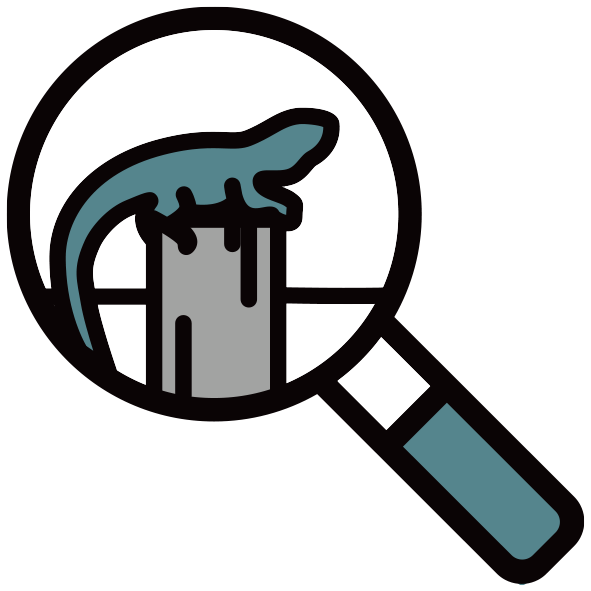The Peri-Urban Environmental Biosecurity Network (PEBN) spoke to Jo Kingston from Friends of Lillico Penguins (FoLP) about what makes the network tick, and what they do for conservation and the environment in their area.
The FoLP program
Can you tell us a bit about the Friends of Lillico Penguins (FoLP)?
We are a branch of Wildcare Tasmania Inc and currently have 43 members. Our volunteer work occurs at the Lillico Conservation Area which is six kilometres west of Devonport. The site comprises 14 hectares and runs for 2.5 kilometres along the coast from the Don River to the Forth River, connecting the bushland along those two rivers with the reserve along the coastal strip.
Besides being the site of the Little Penguin colony and a Shearwater nesting area, the Lillico Conservation Area is also an important wildlife corridor. Consequently, although our key role involves protection of the Little Penguin, our presence there and the varied work we do also helps to protect other species and their habitat.
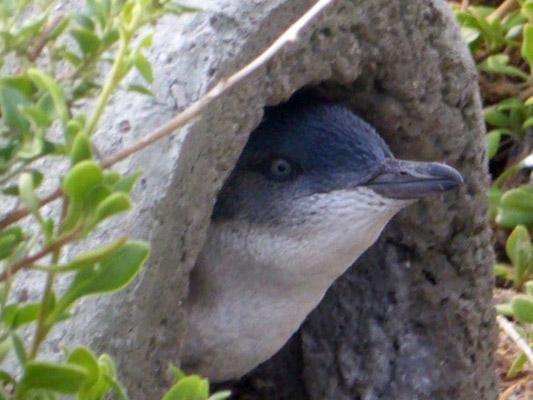
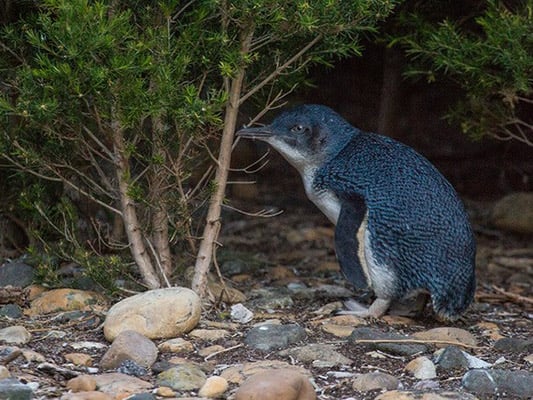
Photos: (Left) Little Penguin adult standing in entrance to its artificial burrow (Photographer: Vicki Purnell) | (Right) Adult Little Penguin under cover of shrubs in its wild habitat in the Lillico Conservation Area (Photographer: Ramit Singal)
What does your work protecting Little Penguins involve?
Our broad aim is to support the goals of the land managers of the site—which is Tasmania Parks and Wildlife Service, part of the Department of Primary Industries, Parks, Water and Environment (DPIPWE).
Our key role is protection of the Little Penguin and the other native species in the Lillico Conservation Area, and for approximately seven months of the year (during the Little Penguin breeding season from September to April) we have between two to four members rostered at the site every night for penguin guiding which starts just before dusk and lasts for at least three or four hours.
Penguin guiding involves interpreting the behaviour of the penguins for visitors to the site, and ensuring that visitors act appropriately (to minimise stress on the Little Penguins).
During the course of the night, visitors may witness burrow renovation, mate selection, courtship behaviours, mating, social behaviours, preening, chick rearing and feeding, and the arduous teamwork of parenting birds. They’ll hear the unique calls of the adults and chicks, and gain insight into how tenacious, disciplined and opportunistic these little survivors are.
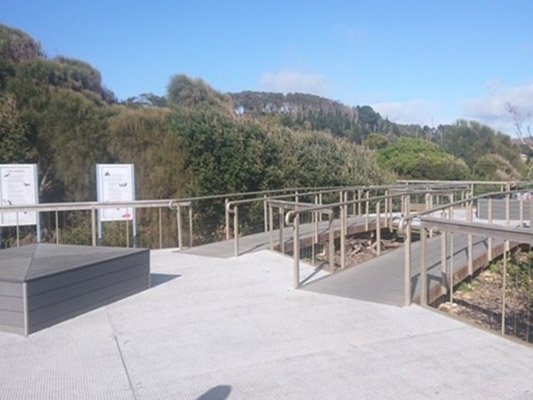
Lillico Conservation Area penguin viewing platform looking towards the north east.
Photographer: Sally McMillan
Visitors come from within Tasmania, interstate and from overseas, with nightly numbers on the platform ranging from around 30 to 200 visitors. During the three months of peak breeding time (when chicks are emerging) numbers increase to around 80 to 200 visitors each night.
Just on dusk, when visitors are gathering on the platform, a member of FoLP (or during peak season, a Discovery Ranger from Parks and Wildlife) will present a short talk which includes advice on how to enjoy the evening without causing stress to the penguins. Some of our members prepare educational material, mostly for children, which is used at the site as well.
With the enthusiasm of the visitors and their many questions, it is usually a very busy night for guides.
With the enthusiasm of the visitors and their many questions, it is usually a very busy night for guides. At the same time of year, Shearwater birds are also nesting and guides spend a little time talking to visitors about Shearwaters as well as other wildlife seen close to the platform. Other wildlife includes Common Ringtail Possums (often in pairs), Tasmanian Pademelons, Water Rats and sometimes, just off-shore, Humpback Whales. Closer to the beach, bioluminescence may also be seen.
FoLP members also report (to rangers or police) any breaches of National Parks and Wildlife regulations, whether these involve Little Penguins or other native species in the conservation area.
In addition, guides contribute to colony monitoring and data collection. At the end of each night, after visitors have left, guides complete monitoring sheets which record a variety of things such as numbers of penguins (adults and chicks), arrival time of first penguin coming ashore that night, numbers of visitors, numbers of other wildlife seen and other details. This information provides a snapshot of wildlife activity for the entire colony which becomes a very valuable record of change over time (our group has been volunteering there for over 25 years and has corresponding records).
Every four years, or when resources are available, FoLP members participate in a survey of the Little Penguin colony conducted by Parks and Wildlife. This volunteer involvement by FoLP has not been possible for some time (more than four years) due to limited resources. However, a survey of the Shearwater colony is being planned by FoLP following a grant from Wildcare.
During winter, when penguins are absent, FoLP undertakes maintenance and arranges artificial burrows based on perceived penguin preferences and usage. We also improve insulation of the artificial burrows by adding rocks, or clay, or growing thick coastal ground cover such as Pigface over the concrete igloos. During working bees we search for and remove rubbish along the beach and in the vegetation. Although, most visitors are very mindful not to litter, the Bass Highway runs alongside the length of the Lillico Conservation Area and there is a large carpark beside the site which is often used during the day as a convenient rest stop for motorists. This means litter can occasionally blow into the conservation area from the road or carpark. Guides also collect and dispose of any litter in the carpark and on the viewing platform each night.
Challenges and successes
What do you attribute the success of the FoLP program to?

Little Penguin adult beside the entrance to its artificial burrow
Photographer: Vicki Purnell
Members usually join FoLP because they love penguins and want to share their knowledge and understanding of the Little Penguin with others, and do everything they can to protect the penguins and their habitat. Penguin guiding is an excellent way of doing this. The enthusiasm and commitment of the volunteers also shows in their interactions with visitors.
Members do far more than relate facts. Guides help visitors to understand what complex and unique birds Little Penguins are, with amazing land and sea adaptations evolved over thousands of years. The focus on the unique nature of Little Penguins, and their vulnerability, shapes the experience of visitors who often comment on the very visible effort and care taken by guides to avoid disturbing Little Penguins.
The absence of competing tourism businesses has enabled FoLP to establish appropriate ways of working at the Lillico Conservation Area which prioritise the welfare of the Little Penguin. Based on Parks and Wildlife advice, and the experience of guides over more than 25 years at the site, FoLP members have adopted protocols (which protect penguins and their habitat) for working at the site during the off-season and for guiding during the breeding season. These protocols include instructions for torch use by guides, areas where visitors are permitted and not permitted, appropriate noise levels, numbers of people on the platform at any one time, how to move around the platform with minimal impact, as well as bans on smoking, alcohol, flash photography, visitor torches and handling of penguins.
The design of the viewing platform has significant advantages which also contributes to the success of our program. The height of the platform and the design of the fencing around it, whilst functional in keeping people and penguins separate, still enables an immersive experience. An overhang gives visitors and guides excellent views of the beach (and penguins emerging from the ocean) while preventing physical access. Elevated red lights attached to the platform provide diffuse, soft, red light over some of the artificial burrows and areas where penguins socialize and feed their chicks. This lights, together with red torches used by guides, are usually sufficient for visitors to see the penguins, thus eliminating the need for strobing visitor torchlights (which would be stressful for penguins and distracting for visitors).
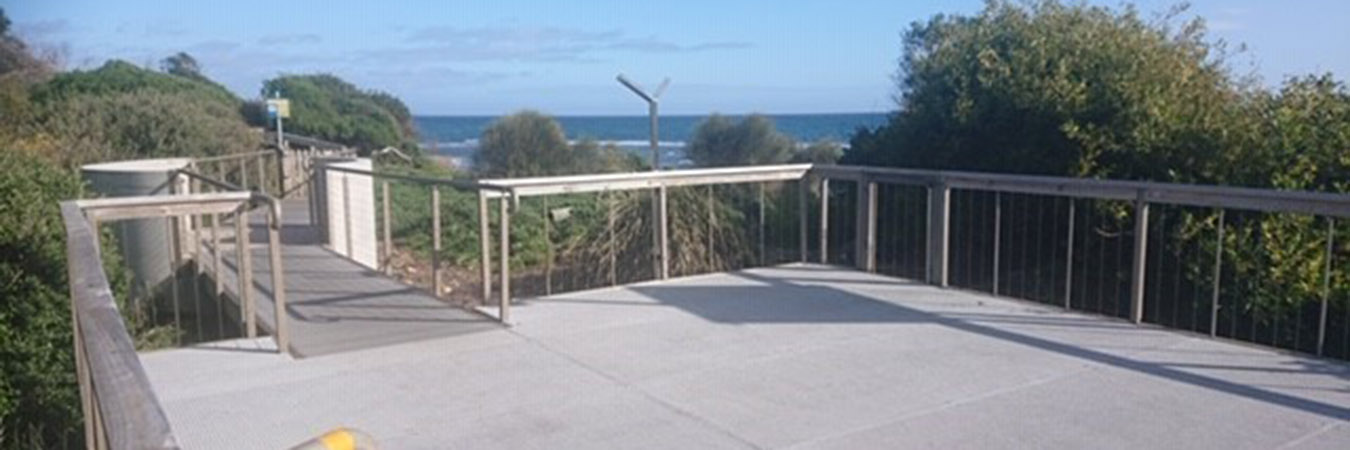
Lillico Conservation Area penguin viewing platform looking towards the north west.
Photographer: Sally McMillan
Support from Parks and Wildlife is also integral to our program’s success. They established the infrastructure (viewing platform and lighting) and provide everything from signage and funding to ranger assistance (with guiding and weeding and rehabilitation). FoLP also benefits from its membership of Wildcare, which enables the group to apply for grants.
Donations from the public are used to cover ongoing annual running costs such as workshops, stationery, equipment, torches, jackets and vests for the group and Wildcare Tasmania Inc membership fees. Donations also fund projects and a percentage are shared with the Burnie Penguin Rehabilitation and Release Centre.
What are some of the challenges faced by the program?
Sustainability of the colony would be the most significant threat. However, on a daily basis the practicalities of guiding tend to take precedence and members are largely concerned with ensuring sufficient numbers of guides each night, working torches, dealing with difficult visitors and limiting penguin stress. Despite this, if the in-shore fisheries dwindle or collapse, or even if a particular preferred marine food species for the Little Penguin becomes depleted, or collapses due to a disease, this would significantly impact the colony. In the off-season Little Penguins can travel long distances to find food, but during breeding season, they must get back to their “dependents” at the burrow as often as possible, and so they cannot travel very far for food and rely entirely on the in-shore fisheries for some months while caring for eggs and chicks.
Although FoLP has no control over the health of the coastal fisheries, it is possible to observe and report any changes in the length of time between feeding of Little Penguin chicks or the appearance (e.g., size) of chicks and adults which could indicate depleted local fisheries. Such observations could prompt investigation by organisations with the resources to do so. However, our current nightly data sheets do not include observations on feeding patterns, size, or health. Extending guide duties to record information about the health and feeding patterns of Little Penguins would be a challenge for our program, but could be the worth the time and effort.
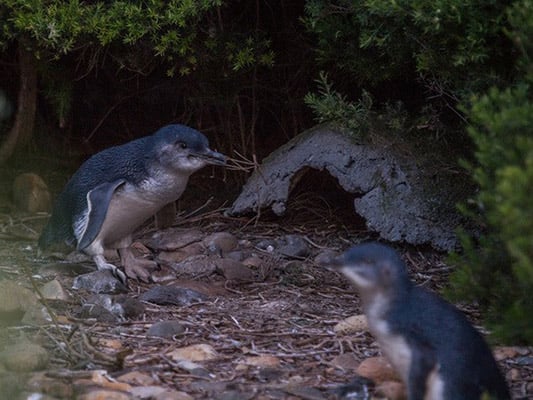
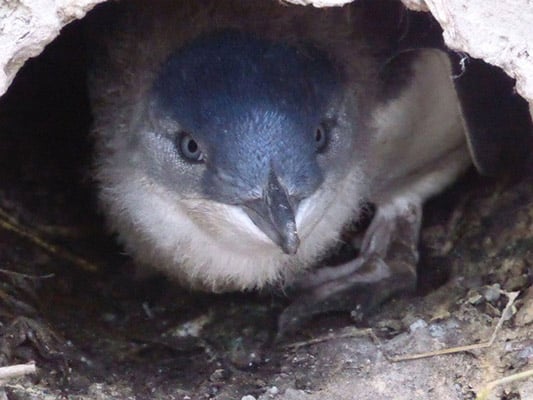
Photos: (Left) Little Penguin chick in entrance to its artificial burrow. It has gained some new adult feathers on its head. (Photographer: Vicki Purnell) | (Right) A group of Little Penguins, one of which is gathering twigs for nest renovation prior to breeding. The nest bowl is usually made deep within a burrow. In this case, the burrow is an artificial one (in the background) (Photographer: Ramit Singal)
Other threats besides fishery depletion would include oil spills, growing visitor numbers, vandalism and poaching, traffic and resourcing.
There is an ever present threat of an oil spill since the Bass Strait is a busy and often extremely hazardous shipping channel due to unpredictable, quick-changing weather patterns and the frequency of gale force conditions and high swells. Members of our group, including myself, have attended workshops with Parks and Wildlife for training in marine bird oil spill rescue. Networks of volunteers across the state have also been established by DPIPWE to take on different emergency roles in the event of an oil spill.
With penguins, the key to their survival is limiting the spread of oil from penguin to penguin and to the burrow. This means oil-covered penguins emerging from the sea must be caught before reaching their mates on land, or before entering their burrows, and must also be prevented from preening and ingesting the oil.
Woolen jumpers for Little Penguins have previously been used successfully in Australia for this purpose. The jumpers are placed on the penguins when they are captured and birds are then transported to various washing hubs where they each wait their turn to have their jumper removed and be washed free of oil. The oiled jumpers are then disposed of. Several members of FoLP took part in a community project to prepare for oil spills by knitting 500 penguin jumpers and these are now stored with the marine oil spill response equipment managed by Parks and Wildlife. These jumpers can be used at Lillico or anywhere else in the state where they may be needed. In the event of an oil spill impacting the Lillico colony, members of FoLP would also work in various volunteer roles under the supervision of Parks staff to help save the Little Penguins.
The number of visitors has exploded
The number of visitors has exploded in the last couple of years and during the peak months of December and January we can get 150 to 200 people most nights on the viewing platform. This increase in the guide-to-visitor ratio often means much longer nights for guides, who sometimes work four or even five hours a night back to back. Workplace health and safety can also be an issue with larger visitor numbers as platform space is limited. Entry to the platform may eventually need to be staggered so that some visitors wait in the carpark while others use the viewing platform.
Whether protocols such as social distancing and hand sanitising practices (required for Covid 19 control) are feasible at the site is being considered. Parks and Wildlife rangers will be discussing the issue with DPIPWE and communicating a decision with members in early September.
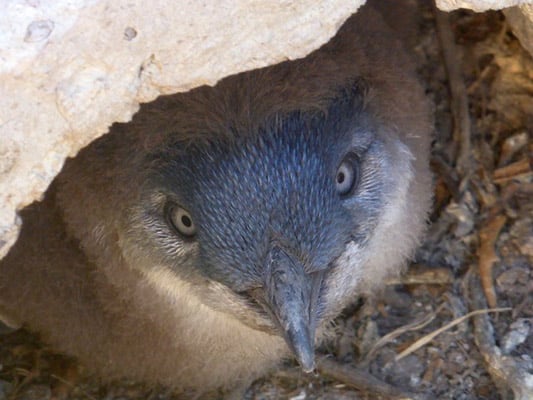
6. Close-up of Little Penguin chick’s face with new adult feathers. Chick is in its artificial burrow.
Photographer: Vicki Purnell
Sadly, we have in the past, during breeding season, had some incidents occur involving vandalism of penguin habitat and poaching of Shearwaters. This has happened during the daytime when guides are not present and wasn’t discovered until their arrival at dusk. CCTV cameras mounted in the Lillico Conservation Area cannot view the entire colony but may lead to prosecution in some cases and so could act as more of a deterrent. Investment in extra cameras may be required.
Accessing reliable and current data for our colony is another ongoing challenge. Due to limited resources over the years, DPIPWE’s data on the Lillico colony and for some other colonies around the state is deficient. Up to date data is lacking on colony populations and trends as well as the future of individual colonies. Government staff and members of community groups who work with the Little Penguin rely a great deal on research from Victoria, which may or may not be relevant for our sites.
While we do take reliable data each night for the far eastern tip of the colony, we have not been able to participate in surveys of the entire colony (recommended to be done once every four years). Most years FoLP has lacked sufficient members to adequately contribute to the survey conducted by Parks and Wildlife of the 2.5 kilometer long beach. However, in the last couple of years FoLP member numbers have almost doubled so this may change.
Another risk is the potential coastal impact of climate change. The habitat of the Little Penguin in the Lillico Conservation Area is already regularly battered by high tides, large swells, gale force winds and major weather events with erosion of the frontal dunes as well as the toppling of trees and shrubs. The vulnerability of this strip of coast and the Little Penguin colony itself is easy to see and is something that will, in the future, most likely seriously challenge the viability of the colony and our capacity to support it.
Finally, noise, lights and pollution from the Bass Highway (which runs parallel the length of the colony) are an ongoing challenge. The highway is the main freight (road and rail) and travel route from the north west to the rest of the state which results in considerable night-time noise and headlight intrusion into the habitat. Surprisingly, this at present doesn’t appear to greatly affect the colony. However, increasing traffic will increase the problem.
A timber fence has been built between the carpark and the penguin habitat at the entrance to the viewing platform and staked mesh fence runs the length of the habitat. This mostly prevents penguins from venturing onto the highway just a metre or so away but is no protection against the odd vehicle that runs off the highway and ploughs into the conservation area. These accidents have in the past damaged the penguin fence, habitat and burrows. Several years ago, a truck carrying a type of oil ploughed into the habitat and covered some burrows, penguins and chicks in oil.
What does your group do to make locals more aware of threats to Little Penguins in the area?
Some of our members are involved in presenting talks. Sometimes these are for local media such as radio (after gaining approval from Parks and Wildlife Services), or talks for community groups (such as Lions and Probus) or at schools. The aim is to ensure that the community is aware of how they can help to protect the Little Penguin and its habitat, as well as responding to any questions the public may have.
Does your group monitor for any existing or potential invasive species which may affect penguins (e.g. feral dogs, certain weeds)?
Yes, during the off-season (in the winter months when the Little Penguins are at sea) our group has working bees in the Lillico Conservation Area. Our plans for these working bees are determined in consultation with Parks and Wildlife Services and usually focus on weed eradication and monitoring of the native species, along with plantings where appropriate to improve the habitat for the Little Penguin and Shearwaters. At times the weed eradication has been monitored by photographic records, especially for some of the more invasive species.
Training and resources
What training and resources do you provide your guides with?
FoLP guides go through a volunteer induction process which involves on-site training with (usually) the Volunteer Induction Co-ordinator. This induction lasts about two nights during breeding season at the Lillico viewing platform, depending on the prior knowledge and experience of the new guide. The inductee is then placed on the roster to volunteer on nights when there is an experienced volunteer as the lead guide.
FoLP also provides group training for new guides at the viewing platform for certain tasks such as how to answer certain questions, how to set up the platform, use of equipment in the platform locker, as well as identifying the various WH&S documents and educational material stored in the locker.
Over the following weeks and months, the trainee works through a training checklist of basic and advanced competencies with the experienced lead guide as mentor. The training checklist is a self-appraisal process, with the trainee checking off the tasks on the list when they feel comfortable they can successfully and confidently perform the tasks.
Once the training checklist is completed, the new guide receives a FoLP fleece jacket and/or fleece vest with embroidered logo of FoLP and Wildcare, as well as a name badge. Also for use by guides are items kept in the platform locker, including a red-light torch and cotton vest with luminous stripes and luminous ‘guide’ label.
Guides are also provided with the FoLP Volunteer Guide Manual, a training checklist, a list of member names and contact details, and a current artificial burrow map for the site.
A member of the Executive (such as the Volunteer Induction Officer or the Roster Co-ordinator) will, after some weeks, contact the trainee and see if they have any concerns or problems. The lead guide on the night when the trainee is rostered may also contact Executive of the group if they have any concerns about the capabilities of the new guide.
Once a year there is usually a combined FoLP and Friends of Burnie Penguins training workshop where DPIPWE representatives and other guests (such as researchers) are invited to speak.
How does the group find information about feral predators and invasive species of concern in their area?
We rely on DPIPWE and, in particular, local Parks and Wildlife rangers, who are very aware of the type of feral predators which may be a threat to Little Penguins. Advice for the general public is also on websites and often messages on this topic are presented by local and state governments in the media. In particular, because penguin colonies in some areas of the state are near housing or towns, dogs and cats can be a problem. At the Lillico Conservation Area, we do not have a problem with domestic pets as the site is some kilometres from built-up or suburban areas. Also, luckily for all colonies, it is believed that there are no foxes in the state (as foxes would be a major predator).
Invasive weed species are a constant concern for FoLP at the Lillico Conservation Area. Our group works closely with a Parks and Wildlife ranger who is our liaison officer with the government department. Besides communicating with Parks on our behalf for a range of matters, she is also our group’s Habitat Officer. In that role she identifies invasive species and advises the best approach of dealing with the problem. Some of our members with horticultural knowledge may also alert her to problem species they have noticed at the site. As part of her role with Parks, she will sometimes work at the Lillico Conservation Area weeding and planting (as well as participating in our working bees at the site during the winter off-season when the penguins are not there.)
Ask an Expert
As part of this interview, the FoLP were given the opportunity to ask questions to the experts of the Peri-urban Environmental Biosecurity Network around exotic pests and diseases that may assist in them in managing biosecurity within their program.
Here are their questions and responses from our experts: Case study_FoLP Ask an expert.
How can you help protect the environment?
If you’re interested in becoming a FoLP volunteer or learning more about the program visit Friends of Lillico Penguins.
Join the Peri-urban Environmental Biosecurity Network
The Peri-urban Environmental Biosecurity Network is engaging people from all walks of life who live, play or work in peri-urban areas to contribute to detecting and reporting new and emerging environmental pests, weeds and diseases. The network offers opportunities to learn through various events offered by our partners or articles on the website. You can also ask one of our experts if you have environmental biosecurity questions. Join our network by following the PEBN facebook page, or subscribe to our newsletter and be notified of the latest articles and upcoming community events.
Acknowledgements:
- This interview was conducted by Rhyll Vallis from the Peri-urban Environmental Biosecurity Network.
- Note: All photos in this article were taken without a flash. Flash photography has a very negative impact on these penguins.
